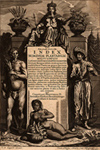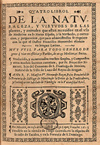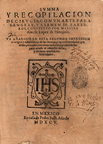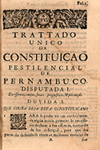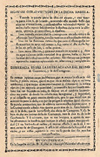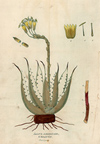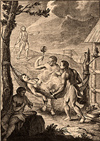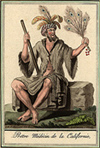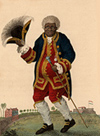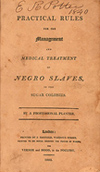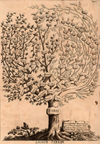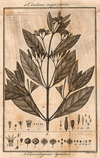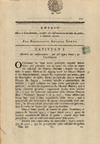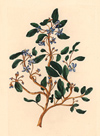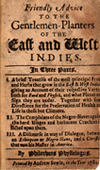ATLANTIC MATERIA MEDICAWestern medicine was born in the Mediterranean world, as the result of cross-fertilization between the rich healing traditions of peoples living in southern Europe, northern Africa and the Near East. It came of age, however, in the Atlantic world. In this new phase of its complex evolution, Western medicine grew out of creative interactions between peoples from Europe, western Africa, and the Americas.From the sixteenth century onwards, the consolidation of long-distance sea routes fueled successive waves of cultural hybridization that had a significant impact on medical practice. Healers and patients traveled along these routes carrying exotic germs, medical textbooks, preconceived notions, and miraculous drugs. These nomadic agents were instrumental in the development of novel strategies for collecting, organizing, and processing vast amounts of information about the human body and the natural world. This exhibit is an attempt to show how transoceanic circulation contributed to the development of some of the healing practices, public health initiatives, and scientific principles that lie at the core of modern Western medicine. |
||
 |
||
[1] Monardes, Nicolás, 1512-1588. top of page Ioyfull nevves out of the newe founde worlde, London: Poules Churche-yearde, by Willyam Norton, 1577. Working from Seville, Spanish doctor Nicolás Monardes managed to compile an impressive catalogue of New World medicinal plants. He bought specimens from merchants and sailors, grew some of them at his own private garden, performed therapeutic experiments on his patients, and interviewed many travelers to obtain information about the uses of the plants among American natives. With more than 40 editions in six languages, his Historia medicinal de las cosas que se traen de nuestras Indias Occidentales, was the most successful book on New World medicinal plants ever published during the sixteenth and seventeenth century. At the John Carter Brown Library we have at least a dozen different copies from this period, originally printed in Spanish, English, Latin, French, and Italian. The first English edition, shown here, contributed to popularizing the medicinal use of tobacco in Northern Europe. |
||
| [2] Acosta, José de, 1540-1600. top of page
Historia natural y moral de las Indias, Seville: Juan de Leon, 1590. Jesuit father José de Acosta became familiar with the New World after living for more than 20 years in Peru and traveling extensively throughout the Andes and Mexico. His Natural and Moral History of the Indies was a major bestseller during the seventeenth century. Although this was not a medical book, it contributed to the dissemination of knowledge about the pharmacological properties of many plants from South America. Acosta was one of the first authors to describe what we know today as altitude sickness, explaining it in clearly secular terms. His defense of the heuristic value of direct observation and first hand experiences had a tremendous impact on scholars like Francis Bacon. Today, Acosta is considered a pioneer in the fields of biogeography, anthropology, and cosmography. In many ways, his work opened the door for novel forms of knowledge systematization, making a decisive contribution to the birth of scientific imperialism. |
||
| [3] Hernández, Francisco, 1517-1587. top of page
Rerum medicarum Novae Hispaniae thesaurus, Rome: Vitalis Mascardi, 1651. Spanish physician Francisco Hernández de Toledo was commissioned by Phillip II to study the natural productions of the New World. Between 1571 and 1577 he worked alongside native healers from New Spain, learning the names and properties of the local plants. As a result, he produced a monumental compilation of botanical descriptions, richly illustrated, and based on Nahuatl nomenclature. The complexity and shear size of the work presented European printers with a tremendous challenge. Several scholars transcribed excerpts from the original manuscript and included them in their own books. In the 1580s, Italian physician Nardo Antonio Recchi produced a condensed version of the original Latin text. This “abstract” was eventually published under the auspices of the Accademia dei Lincei, in 1651. The impact of this volume was significant: Hernández included descriptions of more than 3000 plants from the New World while the most popular herbal of classical times, Dioscorides Materia Medica, included only 600 species. |
||
| [4] Piso, Willem, 1611-1678 & Georg Markgraf, 1610-1644. top of page
Historia naturalis Brasiliae,: auspicio et beneficio illustriss, Lugdun. Batavorum,: apud Franciscum Hackium, ; et Amstelodami,: apud Lud. Elzevirium, 1648. In 1638, naturalist Willem Piso arrived to the Dutch colony in Brazil to work as the personal physician of Governor Johan Maurits. In Recife he partnered with astronomer Georg Markgraf, a member of the Governor’s inner circle. Both scholars worked together on this magnificent Natural History of Brazil, sponsored by Johan Murits and published with the financial support of the Dutch West India Company. Markgraf wrote eight chapters on botany and zoology, while Piso contributed four chapters on medicine. This section of the work includes discussions on trypanosomiasis, dysentery, and ophthalmology. Piso is one of the first European authors to recommend the use of lemons for the cure and prevention of scurvy, crediting local informants with this discovery. It is obvious that Piso and Markgraf were very familiar with the contributions made by Francisco Hernández. Their approach to the expertise of native practitioners was based on a very similar methodology. |
||
| [5] Mentzel, Christian, 1622-1701. top of page
Index nominum plantarum universalis… Berolini: Ex officina Rungiana, 1682. By the second half of the seventeenth century, scholars and humble practitioners working along vast transatlantic networks have become tremendously prolific. This multilingual dictionary of botanical names is one of the most eloquent examples of the impact that their productivity was already having worldwide. Polyglot and physician Christian Mentzel tried to tame the nomenclatural proliferation caused by the publication of works like those of Hernández or Piso and Markgraf. The title page of his book includes stylized representations of America, Africa, Asia, and Europe, arranged in poses that reproduce imperial hierarchies while functioning as an anthropomorphic map of the world. |
||
| [6] Hernández, Francisco, 1517-1587. top of page
Quatro libros. De la naturaleza, y virtudes de las plantas, y animales que estan receuidos en el vso de medicina en la Nueua España… Mexico: Viuda de Diego Lopez Daualos. 1615. Fray Francisco Ximenez translated the excerpts of the Rerum medicarum that Recchi had transcribed in Madrid from Latin into Spanish. This Mexican edition of the work of Hernández constitutes a perfect example of the role of transatlantic circulations in the production of medical knowledge–a book written in New Spain, summarized in Madrid by an Italian physician, translated into Spanish by a priest, and finally printed by a widow in Mexico City. Many practitioners got access to the work of Hernández via this less expensive edition. |
||
| [7] López de Hinojosos, Alonso, 1534-1597. top of page
Summa y recopilacion de cirugia, Mexico: Pedro Balli, 1595. At the turn of the sixteenth century, the practice of medicine in colonial New Spain was already based on a combination of European and native knowledge. Alonso López de Hinojos, a barber-surgeon working at the Hospital Real de los Naturales in Mexico City, learned from his native assistants to use more than 50 local plants. In his Summa y Recopilacion de Cirugia, this Spanish practitioner endorsed native therapies while using the more familiar language of European humoral theory. |
||
| [8] Farfán, Agustín, 1535-1604. top of page
Tractado breve de medicina, y de todas las enfermedades, Mexico: Pedro Ocharte, 1592. Open to a page on curing veneral disease with guaiacum, Agustín Farfán here supplies a long list of drugs taken from a Mexican manuscript copy of Francisco Hernández’s monumental book on New World remedies. Among other procedures inspired by the work of native healers, Farfán described the practice of arthrocentesis, the extraction of synovial fluid from a swelled joint. Similar descriptions had been found in two major compilations of Aztec lore, the Libellus de medicinalibus indorum herbis edited by Juan Badiano and Fray Bernardino de Sahagún’s Historia general de las cosas de la Nueva España. Although some of the richest sources of written information on native medical practices were not widely known at the time, manuals such as these two books by Farfán and López de Hinojos contributed to the popularization of Mexican therapies throughout the Iberian Atlantic world. |
||
| [9] View of Pernambuco. top of page
Anonymous. Reys-Boeck van het rijcke Brasilien, Rio de la Plata ende Magallanes, Dordrecht: Jan Canin 1624. Located in the Brazilian Northeast, Pernambuco was first settled by the Portuguese during the sixteenth century. With its burgeoning cotton and sugar industries, it quickly developed into one of the most prosperous colonies in the Atlantic world. In the 1580s, Pernambuco was the leading sugar-producing region in Brazil. Its flourishing sugar economy, however, made the city a prime target for yellow fever. Sugar mills provided the perfect feeding and breeding grounds for the mosquitoes that were responsible for the transmission of the disease. This link between the rise of sugar manufacturing and the first outbreaks of yellow fever followed a solid pattern throughout the Atlantic. In far-flung places like Guadeloupe, New York, and Saint Nazaire, early epidemics of yellow fever were always preceded by expansions in sugar production or in the refining of molasses. |
||
| [10] Rosa, João Ferreira da. top of page
Trattado Único da Constituição Pestilencial de Pernambuco, Lisbon: Miguel Manescal, 1694. Portuguese physician João Ferreira da Rosa came to Pernambuco in 1687 and worked there for five years before returning to Lisbon. His Tratado includes the first epidemiological characterization of yellow fever. Rosa discussed the possible causes of the disease, described its major symptoms, established its prognosis, and recommended a combination of diet, rest, and local drugs as the best therapeutic approach. This is one of the most influential books in the history of yellow fever epidemiology. A recent acquisition by the JCB, and among our “101” most sought after, only a handful of copies are known to exist. |
||
| [11] Hincapié Meléndez, Cristóbal de, 1689-1772. top of page
Virtudes de la habilla del Darien, que llaman de Guathemala. Guatemala: D. Cristóbal de Hincapié Meléndez, 1739. Although lavishly illustrated botanical and medical books were very important in the transatlantic circulation of erudite knowledge, the fact that they were so expensive to produce made them inaccessible to many common practitioners. Even cheaper versions like the abridged translations of the work of Hernández, were still hard to find outside the main cities. It was through very basic publications, like this humble broadside printed in Guatemala, that botanical information became readily available to the literate masses. This case in particular is very interesting, because printer Cristobal de Hincapié Meléndez was also an apothecary and a surgeon. So, on the front of the broadside he reprinted an overview of the properties of a local emetic known as habilla, originally issued in Mexico in 1737. On the back, shown here, Hincapié Meléndez added a note regarding the differences between the habilla from Central America and the South American emetic known as ipecacuanha. As we can see, even modest publications such as this served to keep medical and botanical information up to date, contributing to the production of new knowledge as well as to the dissemination of the old. Given the ephemeral nature of these publications, a systematic reconstruction of their role is very difficult. For example, no other copy of this broadside is known to exist. |
||
| [12] Balmis, Francisco Xavier de, 1753-1819. top of page
Demostracion de las eficaces virtudes nuevamente descubiertas en las raices de dos plantas de Nueva-España, Madrid: Viuda de D. Joaquin Ibarra, 1794. Nicolás de Viena, an unlicensed Creole healer and apothecary, was told by an old native woman that two Mexican plants could be used to cure syphilis. Convinced of the relative effectiveness of the drugs, Viena passed this information to Spanish surgeon, Francisco Xavier de Balmis. After carrying out a series of trials at the local hospital, Balmis decided to travel to Madrid with a shipment of both plants. His European colleagues were more skeptical, so Balmis decided to run some extra experiments before publishing the entire story in this treatise. During the eighteenth century, the success of drugs like the famous cinchona bark had fueled a renovated interest on New World materia medica. At the same time, the notion that Amerindian medical culture could be a productive source of valuable knowledge came under increasing scrutiny. Some European scholars like Buffon, Robertson, and de Pauw were arguing that the New World was inherently immature as evidenced by the relative size of its animals and the “intellectual inferiority” of its inhabitants. In this context, adding legitimacy to the experience of native and Creole healers required the intervention of licensed practitioners and the use of modern experimental protocols. In the long run, agaves and begonias failed to cure syphilis, but this book was very successful. Translations into German and Italian were published almost immediately. |
||
| [13] Gumilla, Joseph, 1686-1750. top of page
Historia natural, civil y geografica de las naciones situadas en las riveras del Rio Orinoco ... Barcelona: Carlos Gibert y Tutó, 1791. Inspired by the success of Acosta’s Natural History, Joseph Gumilla wrote lush descriptions of native life along the Orinoco River. His characterization of local healing practices was critical of technique, but also very informative. This engraving shows how healers combined the use of plants, which Gumilla lauds, with the performance of the ceremonial dances that he deplores. Alongside other Jesuit scholars, Gumilla was instrumental in collecting evidence to counter the criticisms of Buffon and his colleagues. In fact, the entire volume amounts to a celebration of the riches of Nueva Granada, and many historians argue that Gumilla’s work fueled the patriotic aspirations of Creole leaders like Francisco de Miranda and Simón Bolívar. |
||
| [14] Grasset de Saint-Sauveur, Jacques, 1757-1810. top of page
Encyclopédie des voyages, Paris: De l’imprimerie des Sciences et Arts, 1795. This hand-colored engraving of a “Priest Doctor from California” marks a departure from previous depictions of medical practitioners in the New World. Instead of a group of anonymous native healers interacting with patients, we see a singular, although still nameless, “Doctor”. As in many other images by Jacques Grasset de Saint-Sauveur, the emphasis here is on the costume and the attitude of the native as symbolic markers of his professional status. This image is not exactly a portrait, but it is much more than just a pure emblem or a generic representation of healing practices. |
||
| [15] Stedman, John Gabriel, 1744-1797. top of page
Narrative, of a five years' expedition, against the revolted Negroes of Surinam, Vol. II London: J. Johnson, St. Paul's Church Yard, & J. Edwards, Pall Mall, 1796. William Blake produced this striking engraving using a drawing by John Stedman as his source. Stedman, in turn, had asked ‘Graman Quasy’ to pose for the original portrait. This is one of the first visual representations of an African-born healer in the Americas. Alternatively known as Graman (Great Man) Quasy, Kwasi, or Kwasímukámba, this man showed a remarkable ability to circulate across cultural and racial divides. He was 76 years old at the time he posed for this portrait. |
||
| [16] Straet, Jan van der, 1523-1605. top of page
[Nova Reperta] Amsterdam, ca. 1600. Syphilis ravaged the Atlantic world since the late fifteenth century. Early medical writers knew that the disease was sexually transmitted, and many assumed that it was brought to Europe by Spanish conquistadors. Physicians recommended the use of Guaiacum, a plant from the New World, as the definitive cure for the disease. Commercially known as Lignum Vitae or Holly Wood, this was one of the first American drugs to be commercialized at a grand scale in Europe. This engraving, the title page to the Nova Reperta, an illustrated catalogue of sixteenth century technological developments, shows some logs labelled hyacum or guaiacum at the right of the image. |
||
| [17] Grainger, James, 1721?-1766. top of page
The sugar-cane: a poem.: In four books. With notes. London: printed for R. and J. Dodsley, in Pall-mall., 1764. James Grainger was a doctor trained at Edinburgh, a mediocre poet, and an active member of London literary circles. In 1759 he departed for Saint Kitts where he married into a wealthy family and became a plantation owner. His poem, The Sugar Cane, was an attempt to describe the realities of Caribbean plantation life using the literary conventions of pastoral poetry. For the benefit of his European readers, unfamiliar with the exotic world of the tropics, Grainger included several notes on plants, animals, and diseases commonly found in Saint Kitts. Combining practical medical advice for slave owners with calls for the abolition of slavery, this poem reveals many of the tensions that flourished at the crossroads of slavery, medicine, and empire. Here the book is open to include his notes on yellow fever. |
||
| [18] Collins, David. top of page
Practical rules for the management and medical treatment of Negro slaves, in the sugar colonies. By a professional planter. London: Printed by J. Barfield, 1803. David Collins, a British doctor and planter, spent fourteen years in the Caribbean island of Saint Vincent. Written from the utilitarian perspective of a master, this handbook on slave medicine was clearly intended to maximize the output of the plantation by minimizing labor losses due to disease. Collins emphasizes the importance of providing appropriate diet, clothing, and housing while reducing or eliminating extreme forms of physical punishment. This book is a clear example of the role of slave management in the development of occupational medicine as a modern discipline. |
||
| [19] Monginot, François, 1569-1637. top of page
A new mystery in physick discovered by curing of fevers & agues by quinquina or Jesuites powder, translated from the French by Dr. Belon, with additions. London: Printed for Will. Crook, at the Green Dragon without Temple Barr, 1681. The therapeutic and prophylactic use of quinine against the ravages of malaria was an essential component in the set of medical technologies that facilitated the expansion of Europeans into the Tropics. This powerful drug was obtained from the bark of a tree used by Andean healers to fight chills and other fever symptoms. In the 1630s, Spanish merchants and Jesuit priests became aware of the value of the quina bark and promoted its use across Europe. Books and pamphlets on the plant circulated almost as widely as the product itself. Shown here is the English translation of a French treatise on the “Jesuit powder” or Peruvian bark. This text contributed to the popularization of the use of the drug in England and to its enduring association with the Jesuit order. The illustration shows an Asian healer using trepanation to treat a patient. |
||
| [20] Torti, Francesco, 1658-1741. top of page
Therapeutice specialis ad febres periodicas perniciosas... Francofurti, Lipsiae: In officina Fleischeriana, 1756. Italian physician Francesco Torti made a significant contribution to the development of anti-malarial therapies by establishing that the Peruvian bark was only effective against a particular group of diseases. His “Tree of Fevers” was a highly stylized representation of the cinchona plant, used to map out hierarchical distinctions between different pathological entities. This new way of categorizing and organizing information about disease would have a tremendous impact in the development of medical nosology (the classification of diseases). The notion that individual illnesses could be cured using specific remedies was a radical challenge to the humoral explanations that dominated the medical literature of the time. |
||
| [21] Ruiz, Hipólito, 1754-1816. top of page
Quinologia, o tratado del árbol de la quina ó cascarilla… Madrid: En la oficina de la viuda é hijo de Marin, 1792. During the last three decades of the eighteenth century, the Spanish Crown financed a series of botanical surveys of the New World. The first one involved a systematic reevaluation of the botanical wealth of Chile and Peru. From the point of view of the empire, showcasing the pharmacological importance of South American plants was paramount. Hipólito Ruiz, the director of the expedition, was commissioned to write a monograph on cinchona to demonstrate that Spanish botanists and pharmacists were as capable as their European colleagues. This book became an overnight success, with Italian, German, and English translations following the original Spanish in rapid succession. Creole scholars would eventually produce their own contributions to the taxonomical study of the cinchona tree, recycling for the purpose of nation building the same “patriotic pharmacology” that the empire had used to improve its image among other European powers. |
||
| [22] Gomes, Bernardino Antonio, 1768-1823. top of page
Ensaio sobre o cinchonino, e sobre sua influencia na virtude da quina, e d'outras cascas. Lisboa: Na Typografia da mesma Academia, 1812. Using the pulverized bark of the cinchona tree was extremely cumbersome because the concentration of the pharmacologically active agent was different in each of the available species of the plant. French chemists Joseph Caventou and Pierre-Joseph Pelletier would become famous for extracting, characterizing, and naming this active agent in 1820. Eight years before, Portuguese pharmacist Bernardino Antonio Gomes had published this pamphlet describing his own sophisticated approach to the isolation of quinine from cinchona bark. Gomes had extensive experience as a botanist in Brazil, where the Portuguese Crown had launched a vigorous campaign to find natural substitutes for the expensive bark of the cinchona tree. Rather than reducing this story to a matter of misplaced “scientific priorities,” we should see it as yet another instance of knowledge production through circulation and exchange. |
||
| [23] Byam, Lydia, fl. 1797 - 1800. top of page
A collection of exotics, from the island of Antigua. London, 1797. Lydia Byam produced this series of ten plates illustrating medicinal plants from the British Caribbean. She was less-known than Maria Sibilla Merian who produced a magnificent series of botanical engravings about a century earlier and certainly as interesting, if mysterious. Although she was a member of an aristocratic family, we know very little about her life and work. Shown on this particular plate are the flowers of the same Guaiacum tree that Renaissance physicians used for the treatment of syphilis. This is an extremely rare and valuable book. |
||
| [24] Tryon, Thomas. 1634 -1703. top of page
Friendly advice to the gentlemen-planters of the East and West Indies. London: Printed by Andrew Sowle, 1684. In the 1660s, English merchant and author Thomas Tryon traveled to Barbados and witnessed the horrors of slavery firsthand. His Friendly Advice opens with a treatise on the medical properties of Caribbean botanicals, followed by two severe indictments of plantation slavery. Building on the popularity of New World materia medica, Tryon managed to distribute what constitutes one of the earliest antislavery books written in England. |
||
| [25] Parra, Antonio. top of page
Descripcion de diferentes piezas de historia natural las mas del ramo maritimo, Havana: Imprenta de la Capitanía Genera, 1787. This catalogue of Caribbean fish was the first scientific treatise printed in Cuba. Its author, Antonio Parra, was a Portuguese amateur naturalist and long-term resident of Havana. At the end of the book he decided to include three engravings illustrating a case of elephantiasis in an African slave. It is clear that these images were added to the text in an attempt to capitalize on their shock value. Identified as Domingo Fernández, 32, coachman, born in the Congo, this was one of the first Caribbean slaves to be portrayed in purely clinical terms. Exploited as a medical specimen, Fernández´s status within our story of transatlantic circulations remains ambiguous. In 1812, the Spanish colonial authorities launched an offensive against a group of free blacks who were planning a slave uprising in Cuba. In the house of José Antonio Aponte, accused of leading the rebellion, they found a copy of this book alongside portraits of Toussaint Louverture, Henri Christophe, and Jean-Jacques Dessalines. |
||
| online Exhibition posted in january 2009. | ||
Images may not be reproduced without permission. |

Images: Francisco Hernández, Rerum medicarum Novae Hispaniae thesaurus,.. , Rome, 1651, and
Hipólito Ruiz, Quinologia, o tratado del árbol de la quina ó cascarilla… , Madrid: 1792.





